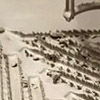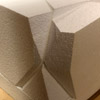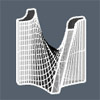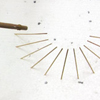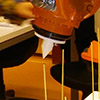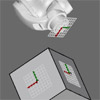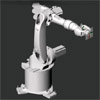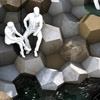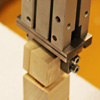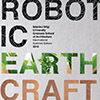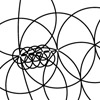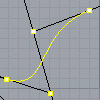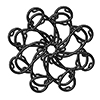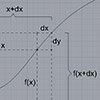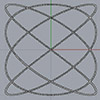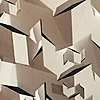I will try to explain the student project called KUKABAE that was developed in my Robotic Fabrication elective course in 2018. This was a very interesting project. Initially, the students were doing the design to attach an ordinary pen holder to the robot. but then the project changed by chance. they decided to replace a pen holder with a ceramic knife. As seen in the video and pictures, the relationship […]
Posts categorized under Research
As the design of free-form architectural surfaces becomes easier, questioning and foreseeing the feasibility of the construction of these surfaces becomes important. Such an inquiry requires sufficient knowledge of architectural geometry besides the knowledge of materials and structural systems. In this article, we present a preliminary example of a guide. It supports the design and production process of building surfaces with different geometric properties is presented. This guide aims to […]
Today, we have studied creating complex robot programs manually again. Platonic solids were the subject of this study. Students tried to create a sequence of robot moves that produces a Platonic solid out of a 17cm EPS cube. We simply call this the robotic hotwire cutting polyhedra exercise. However, the size of our hotwire cutter became one of the problems because of its risk of crashing. We crashed several times […]
This project is developed in the summer workshop titled Robotic Earthcrafts conducted at İstanbul Bilgi University Architectural Design graduate program. Students call this project “ZOM”. Students are Murat Sökün, Zeynep Çakmak, and Özlem Güven. We organized the workshop together with Fulya Akipek and Hülya Oral. You can find more details about the workshop here. In this project, a simple robot code created the EPS molds of the rammed-earth module. Below […]
Today, we tried to understand one of the ways of generating multiple planes in Grasshopper. This is an important step in utilizing the robot program efficiently. Instead of manually jogging the robot, we designed the path that the robot will dig lots of chopsticks. In the “Robotic Chopstick Digger Exercise”, every student designed their own paths and decided the height, orientation, and number of sticks to be dug on an […]
This paper covers ongoing research titled “Growing an Architectural System”. It is an interdisciplinary work relating permaculture studies with computational design and production technologies. It includes testing some issues of performance via full-scale prototypes. Growing Pots is the first study we will mention in the paper. It is about the design of a micro-permaculture system and 3d printed products realized by students of an elective course. On the other hand, […]
Today in the Digital Fabrication course, we examined digital-physical translations utilizing the robots add-on for Grasshopper. Students learn how to get coordinate data from a physical environment, use it in the digital model and apply it to a robot motion. We aimed to dig chopsticks into an EPS block by using a special wooden tool called “Chopstick Digger”. In the first hour of the class, we attached the “pointer” tool, […]
In the Digital Fabrication course, we are in the middle of a sea, full of technical details, and students need motivation. This is why I felt I should do something simple and educational but funny at the same time; a “kissing the cube” exercise. The planned exercise was about programming the robot to touch every facet of a cube without colliding with it. Of course, we couldn’t manage to kiss […]
Today, we started learning Robots add-on for Grasshopper. The first two codes we experimented with were similar to the first week’s jogging exercises. In the first one called “axial jogging”, we had 6 number sliders to control the angles of the axes. Every number slider generates values between -Pi and +Pi. These numbers are joined into a text by adding a comma in between. Then, Create program and Simulate Program […]
On the second day of the Digital Fabrication course, we tried to understand what is a “tool” and how to draw/ produce/ attach/calibrate a simple penholder tool for our robot. This study will hopefully make students aware of the effects of these procedures in robotic design and fabrication. The tool we used here is based on this Rhino drawing laser-cut from a waste plexiglass sheet. The flange of our robot has a diameter […]
This is a competition entry on the innovative uses of natural stone. Urban Polyhedra aims to organize the natural stone usage, especially on the shores. In the current implementation of this system, random blocks are placed to prevent landslides on the urban coastal areas, but restrict the interaction of the citizens with the shore, and destroy the spaces for sea creatures, and vegetation. Thus, this random placement makes it difficult […]
In this semester, I started a new elective course at İstanbul Bilgi University Faculty of Architecture. Second, third and fourth-year architecture, interior design, and industrial design students attend the course titled “Digital Fabrication”. I am very excited to study the basics of robotic fabrication together with the students. I’ll try to report the content of the lectures and the robot exercises on designcoding.net. Below is the general brief of the […]
Can digital design and robot technology be integrated with an ecological design approach? The robotic earthcrafts workshop at Istanbul Bilgi University attempts to relate to biological parameters and digital design and fabrication processes. Thus, the summer school will include seminars and practices on computational design, robotic fabrication, rammed-earth construction techniques, and permaculture design principles to discuss and experience the relationships between technology and ecology. So, the results will be the […]
This video shows the method of constructing equal segments on a line by only using compass operations. Here, you can see that there is a pattern in the number of required compass operations. For example, if you need to divide the distance by 3, you need 13 circles (or compass operations). This reveals a simple equation of c = 2 * n + 3 where n is the desired number […]
I realized this method of constructing basis splines from given control points while searching for a way to teach students about basis splines. I couldn’t find an easy and visual method to create clamped basis splines by connecting simple cubic Bézier spans. It is a tough job and requires lots of complex equations. However, I suddenly realized that there is a special way of doing that. So I decided to […]
Below is the Python code you can run in Rhino, that draws a cubic Bézier curve (degree 3). As you can see, the Rhino Python code is very slow and inefficient because we calculate every point with lots of computations. Instead, we can use the spline formulae to make this quicker but I wanted to show that the mathematical construction is parallel to the geometric one. This is a nested […]
In this short study, I generated Rumi Improvizations. The rumi motif, prevalent in traditional Turkish decorative arts like tilings, window lattices, and fabrics, features a round shape with a comma-like body. Despite resembling stylized leaves, rumis have zoomorphic origins. Rumi compositions depicted stylized animal figures, including birds, lions, deer, fish, and mythical creatures like dragons and Simurg. They symbolized strength, fertility, and the eternal struggle between good and evil. The […]
Yes, interesting topics started to reveal themselves, when I dig into the function curves, especially in the parametric representation. The first interesting application is the “derivative”. Nobody in high school told me that the derivative of a function at a given point gives the slope of the graph at that point. Moreover, it is possible to convert the slope value into an angle in degrees, showing the angle of the […]
This RhinoPython script handles the simple graphs of two-dimensional parametric functions. Therefore, it approximates these functions by drawing parametric curves. It generates many points by solving the functions. The graph of parametric functions is a major topic in most Design Mathematics courses. Because it looks like the building block of many concepts of CAD. However, there is much more to learn before saying that the third degree NURBS is a […]
The Cut & Fold & Craft exercise is the mid-term project for last year’s Computation-based Basic Design Studio at İstanbul Bilgi University Faculty of Architecture. I really enjoyed the technique called Kirigami. Most of the projects are not flat-foldable but they are all cut from a single sheet of paper. This technique seemed a little bit limiting at the beginning, but the students managed to design very interesting compositions in […]

